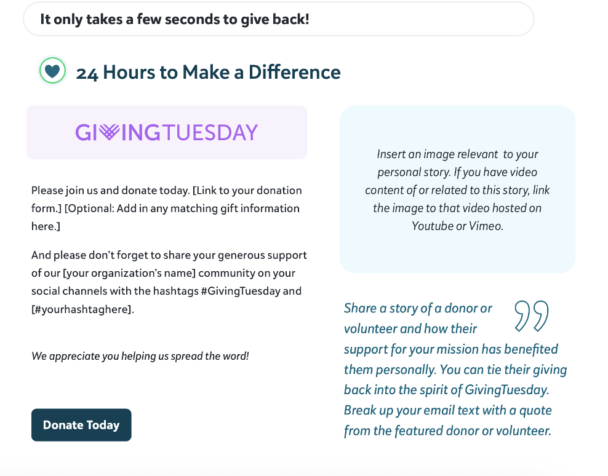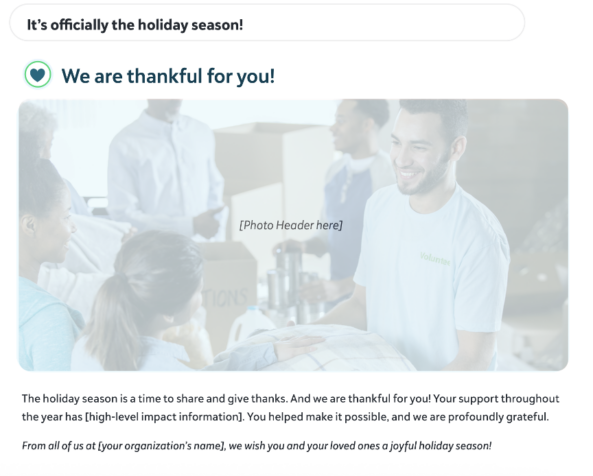GivingTuesday Email Examples, Subject Lines, and Schedule for Sending

No matter your cause, GivingTuesday is the biggest fundraising event of the year for nonprofits and schools. Planning ahead for your GivingTuesday email campaign will help you maximize this once-a-year opportunity and garner transformational support for your mission.
When is GivingTuesday? In 2025, GivingTuesday is set for December 2. That’s less than a month from the end of the year, another big giving day for many nonprofits and schools.
When you start your GivingTuesday campaign strong, you’ll end the year even stronger. And to end strong, it’s best to start as early as possible. Our GivingTuesday email examples and strategy tips are here to inspire you and help elevate this year’s campaign. When you take the time to create a clear GivingTuesday plan, you’ll set your organization up for success now and into the future.
GivingTuesday: A Quick History
Let’s start with the facts about GivingTuesday: It really is huge for nonprofits and schools. How huge? In 2024, GivingTuesday brought in $3.6 billion in the United States alone. That was a record since the online fundraising event launched in 2012.
GivingTuesday isn’t just a fundraiser, though. It’s a way to spark a conversation with your supporters and encourage them to get involved. Last year, 36.1 million people participated in GivingTuesday activities throughout the U.S. To break that down further, 9.2 million people volunteered, and 16.6 million spoke out about causes that were important to them.
Observed in more than 100 countries, GivingTuesday reminds supporters what’s really important: making an impact on their community. Across the globe, millions of acts of generosity take place, such as GivingTuesday Zambia distributing 1,000 back-to-school kits to schoolchildren and GivingTuesday Philippines distributing 2,000 meals to three local communities.
Can your organization participate? Of course, it can!
To get started, encourage your development team to work with your marketing and communications professionals to create an effective GivingTuesday email schedule.
Step-by-Step GivingTuesday Strategy for Your Nonprofit
Step 1: Brainstorm Your Goals
Before jumping into GivingTuesday email examples for this year, take a look back at last year’s campaign. How did it go? Identify what worked and where you can improve before tackling this year. You’ll want to set a clear goal that builds upon last year’s momentum and helps your organization grow.
To strategize, list your organization’s needs. These needs can be:
- Operational
- Related to a specific program
- Capacity building, including purchasing a big-ticket item
If your nonprofit or school is like most, you’ll have a lot of needs. Think of GivingTuesday like a grant application: Focusing on a specific need will make it easier for supporters to understand how their donation will make a difference for your mission.
Knowing which needs to focus on makes it easier to identify your goal. Remember to make it a SMART goal. That acronym stands for:
- Specific
- Measurable
- Attainable
- Relevant
- Time-bound
Here’s an example of a SMART goal. Let’s say your nonprofit runs an after-school program that needs new playground equipment. That’s definitely relevant to the kids!
You’ll research the specific jungle gyms, rubberized mulch, benches, and fencing for the project. Maybe it will cost $15,000, and that seems attainable.
Then, with a time-bound event, you measure the results of your GivingTuesday appeal letter. You’ll know how to track your success because the goal was SMART.
You can consider non-fundraising goals, too. GivingTuesday has a built-in friend-making component. Get your supporters involved in a volunteer project, encourage them to serve as your ambassadors, or help the organization in another way.
Step 2: Create a Strategy Using GivingTuesday Email Examples
Once you’ve chosen your SMART goals, it’s time to create a digital marketing outreach plan for GivingTuesday. The best strategy is to identify a theme for your campaign. Start with a brainstorming session with your organization’s development and communications teams, then check out our GivingTuesday email examples, schedule, and subject line suggestions to get your creative juices flowing.
Use Your Goal as Your GivingTuesday Email Campaign Theme
Depending on your goal, you could build a theme that plays into your objective. For our playground example, you could create a kids’ carnival or outdoor fun theme, and use themed graphics in your emails. Still, your communications should highlight donor impact. As your supporters learn more about your GivingTuesday initiative, they’ll know their donation will go a long way and feel motivated to give.
What’s the Best Timing for Your GivingTuesday Emails?
The best time to begin your GivingTuesday email campaign is to first mention its importance in a series of welcome emails that can be triggered with every new donor. The first email can be sent as soon as their donation has been confirmed. Then, automate another three messages to hit their inbox over the next week or two, with a GivingTuesday promotion visibly placed in the email. Since they’ve just given a gift, highlight ways they can get involved as a volunteer or learn more about your mission.
Also, send updates on your GivingTuesday projects or programs. If someone gave money for a new playground, they’d love to see the photos of kids having a blast on the new slide. When you keep them invested in the work, they’ll continue to support your mission. And remind them in these impact emails that it’s almost GivingTuesday time again.
For regular donors, consider segmenting your email list to send more personalized messages. Would major donors like a private tour? Could you throw a special happy hour on GivingTuesday? Be creative and clear: You can’t make the difference you make in your community without your loyal supporters.
For all recipients, adding regular promotional mentions about GivingTuesday in your email cadences leading up to the event is just smart marketing.
But you’ll need to get serious one week before the actual day.
Example Email to Launch Your GivingTuesday Campaign
Month-before gentle reminders and week-before announcements will give donors time to get excited about your goal without risking donor fatigue. This also gives them ample time to share the giving opportunity with their friends and family members through social media.
Follow this GivingTuesday email example to launch your campaign:
- 1 Month + 1 Week Out | Subject Line: It only takes a few seconds to give back!

Make sure to segment your email list so that those who have already donated won’t continually receive contribution requests leading up to the big day.
Example Email for Your GivingTuesday Holiday-Themed Campaign
Another way to theme your campaign is simply to focus on the holidays, the ideal time to help those in need. In these emails, emphasize your gratitude for the donor’s support and how donations do good for the communities you serve.
Follow this GivingTuesday email example to focus on the season of giving:
- 6 Days Out | Subject Line: It’s officially the holiday season!

Avoid focusing on a specific holiday to include as many potential donors as possible.
Additional GivingTuesday email subject lines for this theme could be:
- We’re thankful for your GivingTuesday support
- This holiday season, think of (insert your nonprofit’s name here)
- We want to celebrate the holidays with YOU
Feature a GivingTuesday Donor or Volunteer
You are likely to have many donors and volunteers who go above and beyond. Asking these supporters to tell their stories and have their photo taken honors them and lets them know how much you appreciate them.
Plus, highlighting their work and support through a GivingTuesday campaign encourages others to step up, too.
Follow this GivingTuesday suggestion to highlight an enthusiastic supporter:
- 5 Days Out | Subject Line: I’m not a hero, but GivingTuesday makes me feel like one!
Ask Recipients to Share
Social media marketing blitzes can complement all of these GivingTuesday email examples. You can create an entire fundraising theme around encouraging people to get involved through social media.
One idea is to ask supporters to post a short video of themselves explaining why they’re donating to your organization. You can use these videos in your emails, too. Just be sure to ask permission and give credit to the supporter.
Follow this GivingTuesday suggestion to amplify reach on social media:
- 4 Days Out + Day Of | Subject Line: Share your best GivingTuesday (elevator pitch/haiku/theme song/TikTok dance/pet photo/friendly challenge)!
Step 3: Schedule Events
GivingTuesday is, in itself, an event. But you also can create an in-person or virtual event on the big day to draw even more attention to your cause. The key is to be creative and visual. A mural-painting contest or a garden clean-up could even get the attention of local media, helping you get more eyes on your mission.
Need inspiration? A Midwestern nonprofit organization dedicated to the environment held a live “treevia” party. This mix of trivia and bingo challenged participants to set a dollar amount to donate for every question they missed.
By the end of the night, the host had collected enough money to buy a new watering vehicle. People shared their scorecards on social media, and the game nights became a regular fundraiser for the organization.
Let your team have fun with your subject lines and email content for GivingTuesday events. Just because your mission is important doesn’t mean fundraising has to be so serious. Supporters love to see organizations get a little playful and creative.
Events can maximize your ambassador and supporter engagement. Help supporters turn inspiration into action by being clear about how they can aid your mission. And ask email recipients to share messages with their friends.
Follow these suggested subject lines to promote your GivingTuesday event but customize with humor or urgency appropriate to your audience:
- 1 Month Out | Subject Line: You’re the first to know about our GivingTuesday (fill in the blank with your event name)!
- 1 Week Out | Subject Line: Invite your friends to our GivingTuesday event!
- Day Before| Subject Line: One day until we (fill in the blank) at our GivingTuesday event!
- Day of Event | Subject Line: You’re still in, right? Today’s the big day!
Stay Mission-Focused with Your GivingTuesday Email Campaign
No matter your goal or email marketing strategy for GivingTuesday, real success can only be defined in relation to your organization’s mission. Always go back to the mission if your team struggles to make decisions about the theme, events, or focus of your fundraising work.
When your efforts are aligned with your mission, it’s a lot easier to know which GivingTuesday email examples will work best for your nonprofit or school.
Final Advice for Your GivingTuesday Email Campaign
Careful planning is extremely important. It’s the only way you’ll know if the added responsibility is manageable. The last thing you’ll want to do is burn someone out during the busiest time of the year.
Work backwards. Sometimes, the hardest part is just getting everything on paper before the first email is sent. Map out a clear communications timeline. Work backwards from December 2 so you won’t miss any deadlines. Delegate tasks appropriately and encourage collaboration to ensure the campaign goes smoothly.
Say thank you. Don’t forget to include follow-up emails as part of your GivingTuesday strategy. All good GivingTuesday email schedules include a message sent after the big day, sharing the campaign’s success and thanking everyone who participated. Do this personally with your team members, too.
Reduce your team’s stress. Blackbaud’s GivingTuesday Guide provides a clear structure to prepare for this exciting fundraising opportunity. Not only are there plenty of thoughtful questions to help you pinpoint a SMART goal, but the guide also lays out every step of the communication plan. It includes a calendar template so you can properly delegate tasks, create deadlines, and keep GivingTuesday momentum going throughout the year.
Downloading the guide is your first step. Then, schedule a meeting with your development and communications teams to see how you can use Blackbaud and Constant Contact’s resources to make this year’s campaign the most successful yet!



